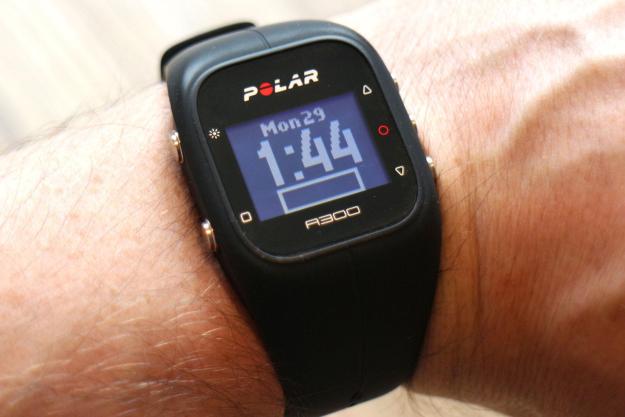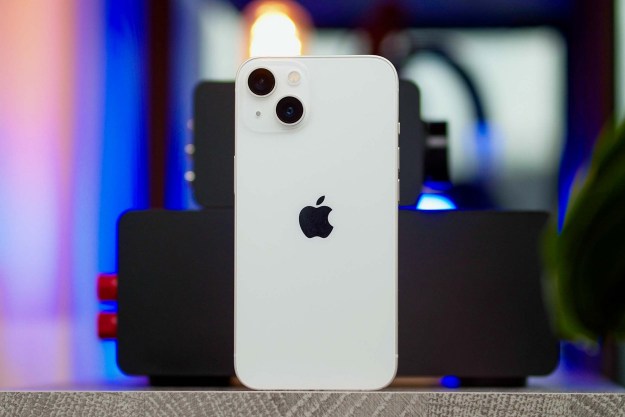
“The A300 could tempt the activity-tracking purist, but style and the smartwatch trend have definitely passed it by.”
- Long battery life
- Waterproof
- Tracks everything
- Decent app
- No notifications
- Chunky and ugly
- No heart rate monitor
- Computer set-up
Polar is a specialist in fitness tracking. The sporty brand offers a wide range of heart rate monitors, fitness and cross-training devices, and GPS sports watches for anyone who is serious about getting, or staying, fit.
The Polar A300 is described as a fitness and activity monitor. At $140, it’s one of Polar’s cheapest options, largely because it doesn’t have GPS or a heart rate monitor built-in. Of course, you can buy a heart rate monitor that straps round your chest, for an extra $40.
The A300 is a big, chunky watch with an alarm function, and it automatically tracks your activity and inactivity. You use it in conjunction with the Polar Flow app, which is available on Android, iOS, Windows, and Mac, to get insights into your training and fitness.
Fitness watches are a crowded market with lots of choice, so how does the A300 measure up? Let’s take a look.
Function over style
When you first look at the Polar A300, you may feel as though you’ve been transported back in time to the ‘80s. It strongly resembles an old, plastic digital watch. Luckily, the silicone strap is fairly comfortable, because you really have to wear the A300 round-the-clock to get the most benefit from it. Sadly, it’s not comfortable or light enough that there’s any danger you’re going to forget you’re wearing it.
The watch face is always on; displaying the time, date, remaining battery, and your progress bar for the day. It’s readable at rest, but you can bring the bright backlight to life with the top left button, if you need more illumination. That button is the first of five buttons around the face – two on the left and three on the right.
At the bottom left there’s a back button. On the right you have your select button in the middle, marked in red, which is used for selecting and starting to track different activities, and buttons to cycle up or down above and below it.
When you first look at the Polar A300, you may feel as though you’ve been transported back in time to the ‘80s.
Once you get to grips with the interface, you can skip around very quickly. Polar also protects against accidental button presses that might stop your tracking, something that can happen quite a lot with fitness trackers. It makes you hold down the back button for three seconds to stop recording a session.
You can pop the main body of the watch out of the silicone strap to charge it. It has a kind of jack at the bottom that allows you to directly plug it into a USB port, but Polar does also provide a short USB to USB cable. The fact that you don’t need a cable is pretty smart.
The design works well from a functional perspective, but bear in mind that you’re supposed to wear this 24/7. Without sugarcoating it, the A300 is ugly. It’s a big plastic watch with a low-resolution monochrome display. Even the silvery buttons don’t do a great deal to elevate the aesthetic. Wear this in a business setting, at dinner, or in a bar, and you’re liable to draw some funny looks.
Shaky setup
The first problem I encountered with the A300 was getting it to work. You have to install the Polar Flow software on your computer and plug your A300 into it via USB. This prompts an automatic setup procedure that involves creating an account and accessing your online diary. If the A300 requires an update and charge, it gets it during this initial setup.
Unfortunately, the first review unit I received was faulty. It took a while, and several attempts to sync, before this became apparent. The helpful support guy at Polar warned me that I might be plugging it in upside down, something that’s easy to do. As it turned out I wasn’t, but I had tried it both ways and couldn’t help wondering why they didn’t make it more explicit in the setup instructions. Polar replaced it quickly, but it was a bad start.

The next unit worked fine, and the setup was finished within 15 minutes. Polar asked for details on things like my height, weight, age, and activity levels.
It’s a bit of a weakness that you have to set things up through a computer like this, but after the initial setup, you can download the Android or iOS app and sync your watch directly with it using Bluetooth. The data will also be saved to your online profile, so you can log in and access it from wherever.
Always tracking you
The A300 tracks your activity automatically without you having to do anything. It will count your steps, calories burned, and distance covered. It also tracks your sleep, telling you how long you slept, and dividing that time into restful and restless sleep, presumably based on your movement.
All the data you put in during the setup is used to come up with a daily activity goal.
All the data you put in during the setup is used to come up with a daily activity goal. I spend most of my day sitting at a computer, so the goal it set for me was quite challenging. As you exercise throughout the day it fills your progress bar on the watch face, and you’ll see a wee animation of it filling whenever you’re active.
You get a breakdown of your activity round the clock in the app, with highlights, and more data as an optional extra that you tap on to expand. It’s well laid out and easy to understand. There are some extra options if you use the computer version through your browser, enabling you to break down your activity into charts and really drill into it.
The app also has a handy section that gives you examples of activities that would help you hit your goal for the day. For example, 46 minutes of tennis, 1 hour 24 minutes of mowing the lawn, 1 hour 53 minutes of circuit training, or 7 hours 16 minutes of pool would hit my daily target. You can access these suggestions in an abridged form on the watch itself by selecting your activity screen and scrolling down. It’s very helpful to get an idea of exactly what would take you over the line, and the suggestions are impressively diverse, and not all sports related, which is good.
One of the nicest features is the inactivity stamps. The A300 will vibrate, and tell you it’s time to move if you sit still for too long at a time. If you pick up a lot of these stamps in a day, it’s a sign you really need to take more frequent breaks and walk around.
It performs like an athlete
It’s difficult to measure the accuracy of the automatic tracking, but for counting steps it certainly seems to work well. It also tracked sleep accurately and could always correctly tell when I was sleeping, versus just being inactive, lying in bed watching Netflix.
With normal use, you could probably get a month out of this between charges.
There are some activities that it’s obviously going to struggle to recognize, so you can tap the action button and choose the right activity at the beginning of a session. Options for sessions include walking, running, cycling, strength training, group exercise, other indoor, other outdoor, and swimming.
You can add all sorts of notes about your sessions, and tell the app how you feel afterwards, but it’s not really picking up on the intensity of each session without the heart rate monitor accessory. There are also additional training charts in the Polar Flow software that never get filled in without that heart rate input.
The Polar A300 is waterproof, and it worked fine in the pool and shower. It can handle depths of up to 30 meters.
Another strength of the A300 is its battery life. Wearing it for a week, and using it a lot, the bar was still significantly above the halfway mark. With normal use, you could probably get a month out of this between charges.
Where it all falls down
Apart from the fitness tracking, the Polar A300 tells you the time and date, and there’s an alarm function. That’s it. It only syncs with your phone to deliver the updated data to the Polar Flow app. There’s no notification functionality, in fact, there’s nothing else to it. That’s fine, because it’s not being billed as a smartwatch — It’s just something to keep in mind when you set your expectations.
The real problem is that, for something you’re supposed to wear all the time, it’s far too bulky and ugly. It’s hard to imagine anyone, beyond fitness fanatics and serious sportsmen and women wearing this, and, in all honesty, they would probably be better off investing a little more and getting something that covers heart rate and GPS as well.
To buy or not to buy?
The DT Accessory Pack
Up your game and the get the most out of your gear with the following extras, hand-picked by our editors:
Polar H7 Heart Rate Sensor ($79.95)
You’ll get a lot more out of your A300 with accurate heart rate monitoring to complement it
Polar A300 Wristband ($24.95)
You can always snag a backup wristband in a different color.
If you just want a simple, easy to use fitness tracker, and you don’t care what it looks like, then the Polar A300 does deliver. You might be persuaded by the accuracy. Polar’s software is also good; it strikes a decent balance between accessibility and power-user options.
The $140 price tag is quite low for a Polar device, but there are tons of activity trackers out there that cost a lot less. This may sound a bit harsh; because the Polar A300 does what it sets out do well. But ultimately, the A300 really drops the ball on style. If you have to wear something 24/7, you’re probably going to prefer something unobtrusive and comfortable.
Highs
- Long battery life
- Waterproof
- Tracks everything
- Decent app
Lows
- No notifications
- Chunky and ugly
- No heart rate monitor
- Computer set-up
Editors' Recommendations
- Polar’s newest smartwatch could be a Fitbit and Garmin killer
- The Polar Ignite watch rekindled my fitness efforts and then doused them again











